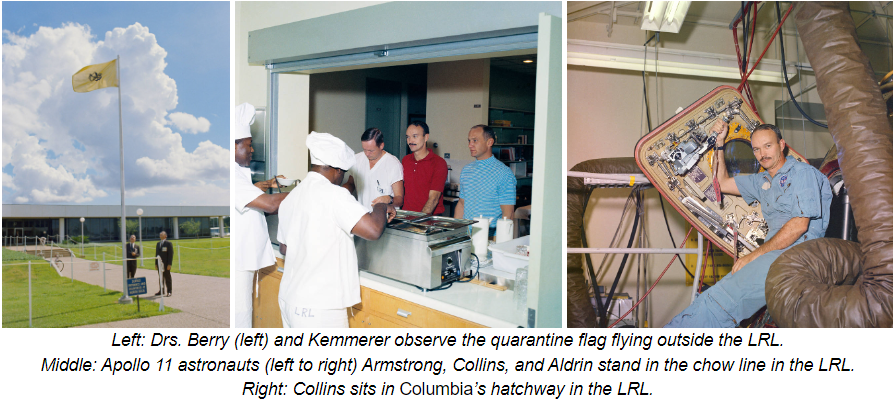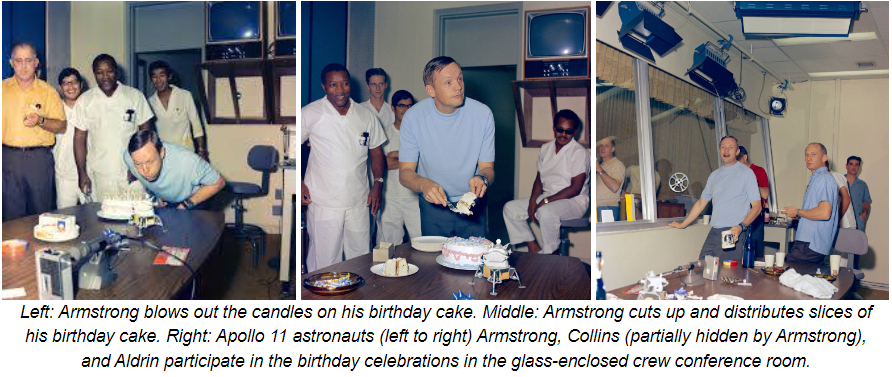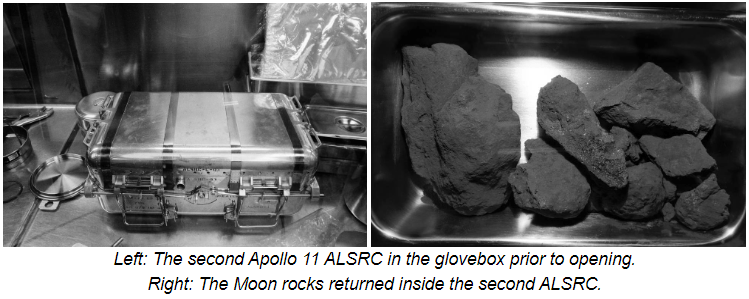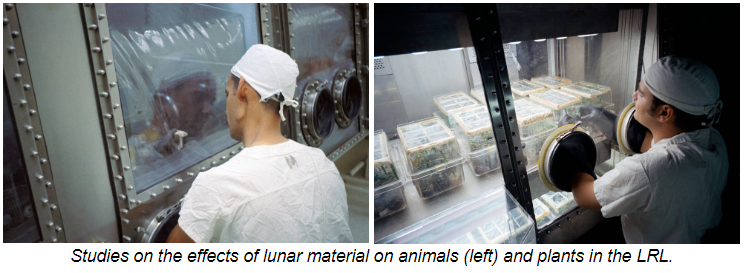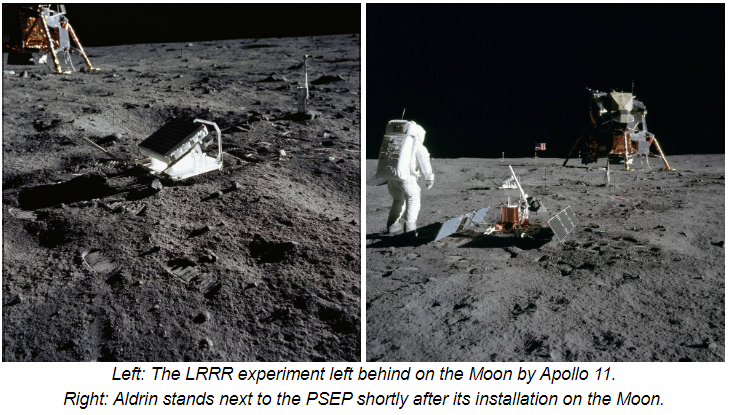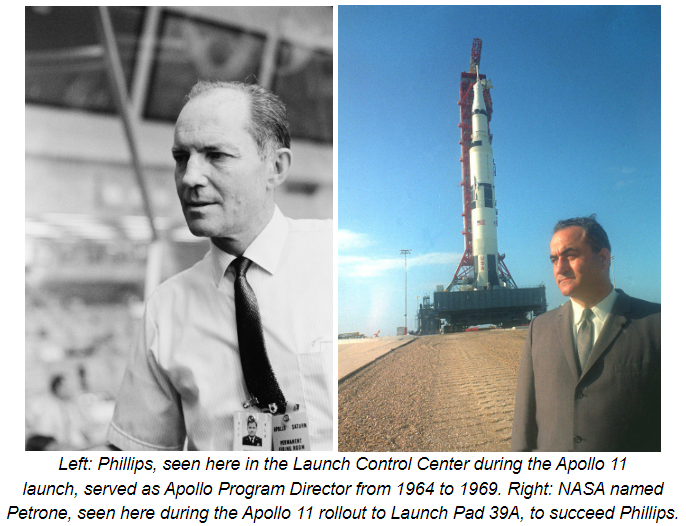The first human Moon landing mission ended on July 24, 1969, with the splashdown of Apollo 11 in the Pacific Ocean. Within a few hours, the 49 pounds of precious Moon rocks were on their way to the Lunar Receiving Laboratory (LRL) in Building 37 at the Manned Spacecraft Center (MSC), now the Johnson Space Center in Houston, arriving the day after splashdown. The astronauts, Neil A. Armstrong, Edwin E. “Buzz” Aldrin, and Michael Collins arrived two days later, and their spacecraft, the Command Module Columbia, followed at the end of the month. Humans and spacecraft and samples were all required to complete the mandatory 21-day quarantine period in the LRL to prevent back-contamination of the Earth by any possible lunar micro-organisms.
For the astronauts, being in quarantine in the LRL meant that their primary postflight activities, debriefs of their mission with management, would be conducted from inside a glass-walled conference room to maintain their biological isolation. The astronauts examined Columbia and retrieved personal items from the spacecraft that took them to the Moon and returned them safely to Earth. Inside the LRL, flight surgeon Dr. William R. Carpentier daily monitored the astronauts’ health, who showed no signs of any infections with lunar organisms. Dr. Craig L. Fischer, Chief of the Clinical Laboratory, monitored the health of the other 20 personnel, including six additional employees who were brought into the quarantine due to breaches in the biological barrier in the sample processing area, none of whom showed any symptoms. From outside the LRL, Dr. Charles A. Berry, Director of Medical Research and Operations, and Dr. Walter W. Kemmerer, Chief of the Preventive Medicine Division, monitored the overall status of the quarantine. Two representatives from the World Health Organization visited and inspected the facility and declared it to be well-run and organized.
The astronauts’ routine was modified on Aug. 5, when workers in the LRL threw a surprise birthday party for Armstrong who turned 39 that day.
The LRL kitchen staff baked and decorated a birthday cake, including candles that Armstrong heartily blew out. He then sliced the cake and handed them to the LRL personnel. The astronauts’ wives watched across the glass partition, and Armstrong teasingly pretended to pass slices of cake through the glass.
Soon after the first Moon rocks arrived at the Lunar Receiving Laboratory (LRL) on July 25, teams of scientists and technicians began examining them. Within two days of arriving on Earth the first Apollo Lunar Sample Return Container (ALSRC) was opened by scientists. This container included the documented samples that Armstrong collected during the latter part of the spacewalk as well as the two core samples that Aldrin collected and also the Solar Wind Collection experiment. Scientists opened the second ALSRC that contained the bulk samples collected early during the spacewalk on Aug. 5. Initial examination of the Moon rocks revealed that many contained bubbles or cavities, likely formed by gases trapped in the molten rocks as they cooled. The lunar dust contained a large proportion of tiny glass spheres, likely contributing to the slippery nature noted by the astronauts during their spacewalk. Chemical analyses revealed that some of the samples contained a high concentration of the element titanium – up to six percent in one sample – an element that is relatively rare on Earth.
In early August, scientists in the LRL began testing the lunar material for the presence of any potentially harmful toxins or microorganisms. Samples from the two core tubes and from the documented samples were introduced to a variety of living organisms, none of which showed any abnormalities. Additional more comprehensive studies begun on Aug. 11 similarly showed no ill effects from exposure to lunar materials on any of the organisms studied. Once scientists determined that the Moon rocks harbored no harmful microorganisms, beginning in mid-September samples were released to 142 principal investigators chosen by NASA from the United States and eight other nations for more in-depth studies.
Armstrong and Aldrin left two science instruments on the lunar surface as part of the Early Apollo Surface Experiments Package (EASEP). The Passive Seismic Experiment Package (PSEP) was designed to detect any Moon quakes and the Laser Ranging Retro-Reflector (LRRR) contained an array of mirrors to reflect a laser beam sent from Earth for precise measurements of the Earth-Moon distance. The PSEP was sensitive enough that it picked up the astronauts’ footsteps while they were walking on the Moon as well as the impacts of the objects such as spacesuit backpacks that they jettisoned at the end of the EVA. After their departure, the PSEP registered over two dozen seismic events that geologists postulated were landslides within craters as a result of extreme surface temperature variations between the lunar day and night. The PSEP stopped working on Aug. 25, most likely due to overheating in the harsh lunar daytime. As far as the LRRR, on the 13th day of attempting to register a laser bounce back from its array of mirrors, scientists at the Lick Observatory in California finally had success with the instrument. Researchers continue to use the LRRR, as well as two others left on the Moon by later Apollo missions and a similar instrument on the Soviet Lunokhod 2 lunar rover, to closely monitor any changes in the Earth-Moon distance. Based on these studies, scientists have determined that the Moon is receding away from the Earth at a rate of 3.8 centimeters per year.
The first of several changes in top NASA management following the Apollo 11 mission took place soon after the flight. On July 31, Secretary of Defense Melvin R. Laird announced the assignment of Lt. Gen. Samuel C. Phillips, who had served as Apollo Program Director in the Office of Manned Space Flight at NASA Headquarters since 1964, to be Commander of the Air Force Space and Missile Systems Organization in Los Angeles, effective Sep. 1. Phillips had overseen the Apollo Program through its critical development years and played a key role in the recovery from the January 1967 Apollo 1 fire. His leadership and management were instrumental in the achievement of the first human lunar landing within the timeframe set by President John F. Kennedy. On Aug. 22, NASA named Rocco A. Petrone, Director of Launch Operations at Kennedy Space Center, to succeed Phillips, also effective Sep. 1.
J


























